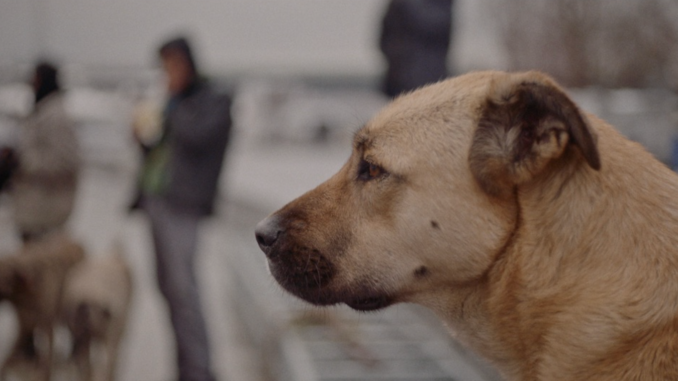
Stray, a ruggedly poetic documentary about stray dogs in Istanbul, has some extraordinary moments of eerie emotion in it, including one near the finish that’s as haunting and amazing as anything I’ve encountered in movies this year.
Elizabeth Lo’s film is about more than stray dogs, but a big part of its unique fascination comes of Lo’s filming her subjects from a close-to-the-ground camera angle that approximates, or shares in, something akin to a “dog’s-eye view.” Even as that camera gives us passing glimpses of people and scenes in some rough urban neighborhoods, the dogs remain the central focus and, in effect, the main characters.
The film’s cast list includes some homeless kids, Syrian refugees who are identified by first-name only. At the top of that list, however, are three dogs—Zeytin, a large tan female who is in effect the film’s star; Nazar, Zeytin’s frequent and similar-looking companion; and Kartal, a black-and-white puppy who cavorts with the strays and is briefly spirited away from its private owner.
The homeless kids take an interest in the dogs and for a while share sleeping space with them. The occasional bits of overheard human speech occur mostly in moments where the camera is watching at least one of the dogs. There is no voice-over narration, but Lo uses a few title cards quoting the classical philosopher Diogenes to set up certain thematic possibilities: “Human beings live artificially and would do well to study the dog” (360 BC) and “I nuzzle the kind, bark at the greedy, and bite scoundrels” (363 BC). Lo’s “study” at least partly reflects the urgencies in those quotations, but in ways that both evoke and complicate them, via contrasts as well as parallels.
Another classical quotation, from Themistius (325 AD), tells us that dogs “keep watch over human beings” not to protect their property but rather to insure that “they do not get robbed of their integrity.” Lo’s film doesn’t find much evidence of human integrity, but a remarkable kind of dignity emerges in her close-ups of dogs, and of Zeytin in particular, often in contrast to the bedraggled chaos of humans nearby.
A prevailing irony in Stray has to do with human beings treating dogs better than they treat themselves and others. (Turkish law forbids the capture and/or killing of stray dogs.) The homeless kids seem to relish their own moments of frolicsome dog-like freedom, but their own survival is, at the very least, in peril.

The social politics of dogs and men looms largest in the second half of the film, but moments evoking the mysteries of dogs’ lives prove the most memorable and rewarding. An especially revelatory moment, for example, arises in a single, quietly composed, beachside shot. Zeytin and Nazar are sitting calmly, the one gazing along the shore, the other sleeping with his back to the shore. A cat, at a distance from the dogs, strides into view; neither dog seems to notice, but suddenly both spring into action and dash off in the direction of the cat. The sleeping dog and the sitting dog give no signs of having noticed until, suddenly and simultaneously, both of them seem—absolutely—to know.
The eerily enchanting moment that I mentioned at the outset comes after the main action has finished and the final credits have begun to roll. It involves a dog (Zeytin, I think) howling mournfully and almost musically. To get the full context and impact of that moment, it’s probably best that you see the movie yourself, before I say anything more.
Stray is now streaming via most major services.

Be the first to comment